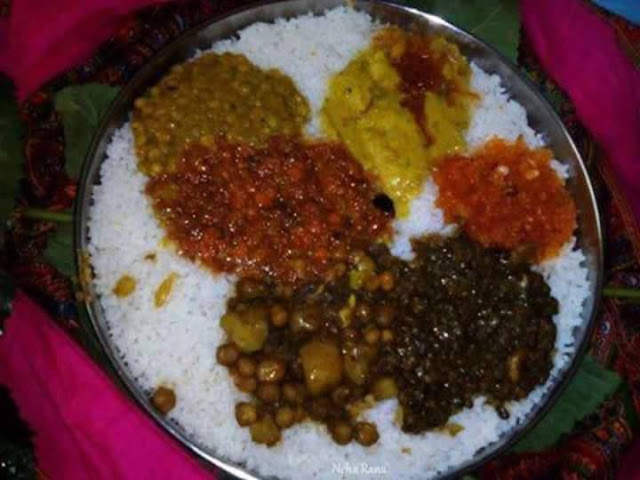Centuries-Old Recipes & Cooking Methods: We Unravel a Unique Himachali Kitchen Secret for You
The entire meal is satwik, which means even onion, ginger or garlic is not used to prepare it.
Sanjay Mishra’s family have been traditional chefs since generations.Called Boti in Himachal Pradesh, these folks cook dham, the traditional festival food in the state.
There was a time when Sanjay felt like leaving his family tradition and getting a regular job, but he realized that Pathiar in Kangra district of Himachal, once known for its Botis, had very few remaining. He came back to his village and started the tradition again by cooking dham. He has since cooked in hundreds of occasions and has been invited by celebrities, politicians and cricketers to cook dham for them. He is also teaching this art to the next generation.
Himachal borders Punjab on one side and Jammu on the other, and the food here has some influence of both the states.
It is believed that about 1,300 years ago, Jaistambh, the then-King of Himachal Pradesh, liked the Kashmiri Wazwan so much that he ordered his cooks to prepare a similar meal without using meat. Thus a new menu was evolved in Himachali cuisine, eventually known as dham.

PHOTO SOURCE
Initially dham was served only as a prasad in temples and hence only a particular Brahmin community of cooks called the Boti were allowed to prepare them. The entire meal is satwik, which means even onion, ginger or garlic is not used to prepare it. However, with time, dham was served on every occasion and gathering like marriages, family events and religious events in Himachal Pradesh.
Another unique aspect of the dham is that no vegetables are used in any of the dishes. It is purely made from various types of lentils and dairy products. The vessels used to cook dham are called charoti, which are pot-shaped copper vessels with a narrow opening. The shape and thickness of the vessel helps the dham remain hot for a longer time. It is slow-cooked on woodfire in a rasialu (kitchen), which is normally a 6′X2′ trench.
According to Boti Sanjay Mishra, cooking in such manner gives the dham a unique flavour and the flame from the wood kills all the possible germs.

The traditional Dham differs in every region of the state. However the Kangri Dham is the most famous among all, which comprises of almost 10 to 11 dishes.
The typical menu for dham starts with rice, moong dal and rajma (red kidney beans) or chole (chikpea),which is cooked in yogurt, prepared in unique style by adding approximately 20 spices called as madrah.

IMAGE SOURCE
This is the main dish of the Dham and the entire gravy is made by cooking khoyaand yogurt in desi ghee until it reduces to the consistency of a thick gravy.
This is followed by a dish cooked by mixing three types of dals-moong, urad and masoor, and is called the ‘maash’ dal.
It is said that this combination of complementary nutritional elements was consumed by Aryans and it can be found in the 1,500 year old Aryan literature. The dal is made by smoked cooking method where mustard oil is put over a piece of burning coal and put in the dal. It is then covered for some time to get the smoky flavour. This technique has been adopted from the Adivasis, who used to cook in small pits filled with smoke. Himachalis call it the Dhuni technique.
The maash dal is topped by khatta (sweet & sour sauce) made of tamarind and jaggery. Unlike the other dishes, khatta is prepared in an iron vessel. It is said that khattahelps remove the fats of the madrah made in pure ghee.

The dham ends with the mitha bhaat – sweet rice or mithdee (made of boondi or bread crumbs etc.).Dishes in a Kangri dham are devoid of artificial colours and are a perfect blend of oils and spices essential for the body.Technique and order of serving dishes are based on vedic traditions in which it is mentioned that sweet rice helps in digestion.
Boti Sanjay Mishra has a special tip: Use burnt, powdered and finely strained walnut to give a special flavour and natural green colour to dishes like chuara mathri and maani. This helps in digestion as well.

The traditional dham is served on plates made of dried leaves of sal and banyan trees, weaved together with thin pleats of bamboo wood, called pattals.

PHOTO SOURCE – DIVYA HIMACHAL
The traditional way of having dham is by sitting together on the floor in a line. This was used to imbibe the feeling of equality among all the communities in earlier times. However, these days, buffets are preferred to savour this style of traditional food.
“There was a time when Botis were almost extinct but now we have again taken up this profession and many young boys learn this art from us. Pathiar, which was famous for Botis, is again full of Botis now,” Sanjay smiles.
To know more call Sanjay Mishra on 9816457888.

Comments
Post a Comment